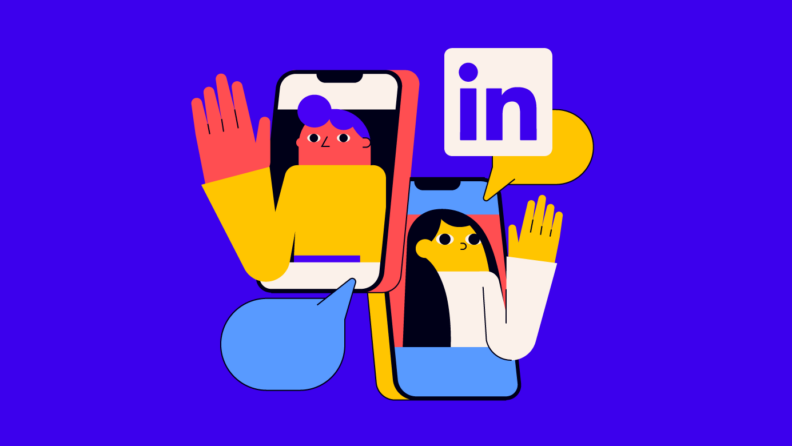In today's marketing environment, a whopping 92% of buyers trust an influencer more than an advertisement or traditional celebrity endorsement.
While we may be familiar with the 'influencer' term from B2C marketing (it's become so popular that there's even influencer marketing software available to support it), this staggering statistic reveals the immense potential of B2B influencer marketing for those brands seeking to elevate their outreach, too.
Influencer marketing signifies a strategic departure from conventional B2B tactics like cold calls and trade shows, trading it for acts like forging genuine relationships, mastering storytelling, and leveraging personal brand.
With over 20 years of experience, I have witnessed firsthand how organizations can embrace innovative engagement to build meaningful connections with target audiences. In this article, I reveal valuable public research and lessons from my extensive tenure guiding influencer campaigns to share proven, actionable strategies you can harness to transform your brand’s relationships.
The Rise Of B2B Influencer Marketing
Influencer marketing, once the domain of B2C brands and lifestyle products, has rapidly gained traction in the B2B sector. Platforms like LinkedIn have become grounds for these partnerships. But why LinkedIn, and why now?
Understanding The LinkedIn Advantage
LinkedIn stands out as a pivotal platform for B2B influencer marketing for several compelling reasons:
- One of the essential strengths of LinkedIn is its professional audience. Approximately 80% of B2B social media leads come from LinkedIn, underscoring its significance in reaching professional demographics.
- The platform is also a gateway to an extensive amount of business decision-makers, with over 65 million users holding influential positions in their organizations. This high concentration of professionals and decision-makers makes LinkedIn an unmatched arena for targeting the right audience.
- Credibility is another cornerstone of LinkedIn's appeal. As one of the oldest social media platforms, it has consistently upheld its reputation as a reliable source of industry insights and professional discourse. By encouraging collaborative and cooperative thinking, the platform is inherently designed to foster credibility and thought leadership.
- LinkedIn' reach is another factor. With about 930 million users, the platform is filled with content daily for professionals seeking to make industry connections, discover new learning opportunities, and find brands worth collaborating with. The potential for content to extend beyond one's immediate network is significantly high, offering extensive exposure.
- Lastly, LinkedIn is known for sales opportunities. The platform's ecosystem, populated with many business decision-makers, is particularly conducive to lead generation and conversions.
Tips and Best Practices for Effective B2B Influencer Strategies
Now, creating an influencer program is simple. It's the execution where people tend to get stuck. The following are helpful tips and best practices:
- Identify the Right Influencers: Partnering with influencers who resonate with your brand values and genuinely connect with your target audience is crucial to social media reputation management. Look for popular influencers with a track record of engaging meaningfully with their followers.
- Build Long-Term Relationships: Consider influencer relationships as long-term partnerships rather than one-off transactions. Communicate with them regularly, involve them in product development discussions, and seek their feedback. This approach fosters a deeper connection and makes the partnership more authentic and effective.
- Create Content That Resonates. Your content must provide value to your audience. Instead of overtly promotional information, focus on creating material that educates or entertains your audience. This approach ensures that people engage with the content, thereby increasing the impact of your influencer partnerships. If you are unsure what content is most desired, leverage "Voice of customer" (VoC) tactics.
- Utilize Various Content Formats. Experiment with different content formats like articles, blog posts, videos, and podcasts. This variety keeps your audience engaged and caters to other preferences.
The Key to Authentic Connections
The key to successful influencer partnerships on LinkedIn lies in authenticity. It's not just about having an influencer endorse your product. It's about creating genuine conversations in your industry.
For instance, a better approach is to collaborate with influencers on content that addresses challenges or innovations instead of just promoting a product. This showcases your company and positions your brand as a thought leader.
The Power of Micro-Influencers
Micro-influencers represent a unique and increasingly significant segment in the influencer marketing landscape. Their power lies in their ability to engage niche audiences with a level of authenticity and specificity often unattainable for macro-influencers.
This segment of influencers brings distinct advantages, making them invaluable for targeted marketing strategies. Benefits include (as explained in Grin Blog):
- High Engagement Rates: Micro-influencers typically boast higher engagement rates than their counterparts with larger followings. Their smaller audience size allows for more personal interactions, fostering a sense of community and trust.
- Authenticity and Trust: Micro-influencers' authenticity is a key factor in their appeal. They are often perceived as more relatable and trustworthy by their followers. This authenticity translates into a stronger influence over purchasing decisions.
- Cost-Effectiveness: Engaging with micro-influencers can be more cost-effective than partnering with high-profile influencers. Their rates are generally lower, offering a higher return on investment for brands with limited marketing budgets.
- Localized Influence: Many micro-influencers have a strong local/regional following, making them ideal for localized marketing campaigns and providing an authentic, relevant voice.
- Creative Collaborations: Micro-influencers often bring creativity and personalization to their collaborations, creating content that resonates deeply with their audience.
- Building Long-Term Relationships: Brands can benefit from long-term partnerships with micro-influencers, leading to sustained brand loyalty and continuous audience engagement.
The Caution Of "Fake Famous" In Influencer Marketing
The HBO documentary 'Fake Famous' explores the complex nature of fame in the digital age by manufacturing fame through the purchase of fake followers and engagement. This raises questions about online influence and impact.
Here are some of my insights from the documentary:
- Fame is not about talent anymore but who can best game the system
- Social media is a curated, edited highlight reel
- Fake influence creates an unsustainable, deceptive cycle
- Fame can negatively consume individuals
- Online fame is fragile and fleeting
Brands must look for red flags like fake followers, excessive sponsored posts, and inconsistent messaging. Authentic influencer marketing focuses on trust and genuine connections, not superficial fame. This cautionary tale emphasizes the importance of authenticity in the influencer sphere.

B2B Influencer Marketing Case Studies
We can learn a lot from B2B brands doing Influencer Marketing right. Let's look at a few business case studies and pull insights from the outcomes achieved:
LinkedIn: Harnessing Professional Influence
LinkedIn, with over 500 million professionals, 61 million influencers and 40 million decision-makers, is a robust platform for B2B influencer marketing. They have effectively utilized influencer marketing by collaborating with B2B influencers in resources like “The Sophisticated Marketer’s Guide to LinkedIn.”
This guide, enriched with insights from various social media and digital marketing experts, ends each chapter with an “Ask the Expert” section, providing valuable Q&As. The involvement of influencers adds credibility to the guide whilst also extending LinkedIn's reach through their networks.
SAP: Engaging Corporate Executives and Experts
SAP, a leader in enterprise application software, leverages influencer marketing by involving top corporate executives and industry experts in their events.
For instance, in a recent event in Germany, SAP invited five influencers to discuss topics like machine learning and IoT. The presence of these influencers led to the event trending in Germany for two days and drove 50% of all social media mentions about the event.
Another event in Florida saw collaboration with 11 influencers, reaching 80,000-100,000 people online through live video streaming.
American Express: "Love My Store" Campaign
American Express’ “Love My Store” campaign is a prime example of effective B2B influencer marketing. Collaborating with influential bloggers Grace Bonney and Emily Henderson, the campaign aimed to inform customers that small businesses accept credit cards and to promote American Express.
This campaign led to the distribution of 400,000 Amex decals and garnered 5 million impressions. Additionally, their #AmexAmbassador campaign further demonstrates their commitment to influencer marketing, targeting executives and businesses for their premium services.
Microsoft: Empowering Women in STEM
Microsoft’s #MakeWhatsNext campaign, launched on International Women’s Day 2017, partnered with National Geographic’s photography influencers to encourage women in STEM (Science, Technology, Engineering, Mathematics).
This campaign, which involved 30 female scientists and adventurers, reached 91 million people and earned 3.5 million likes on the launch day. It exemplifies how influencer marketing can be used for social causes and corporate social responsibility.
Cisco: Creating the Cisco Champions Program
Cisco’s innovative approach to influencer marketing led to the creation of the Cisco Champions program. This program focuses on IT professionals, allowing them to showcase their expertise and knowledge of Cisco products.
Cisco Champions were featured in blog posts, video series, and podcasts, and were given exclusive access to products and events. This program resulted in over 8000 social media mentions and 55,000 tweets about the brand, highlighting the success of leveraging a community of expert professionals.
InspireBeats: Podcast-Driven Lead Generation
InspireBeats, focusing on lead generation for startups and larger companies, used influencer marketing to drive leads to their website and increase conversions.
They aimed to create ten guest blogs, ten podcasts, and ten blog features with influencers every month, targeting podcasts with more than 3000 listeners per episode. This strategy led to a substantial increase in leads and built credibility among industry leaders, generating B2B leads worth $12 million.
PwC: The Oscars Campaign
PwC’s influencer marketing strategy for the Oscars was unique, focusing on creating brand awareness about their association with the Academy Awards and engaging millennials.
They used an actual briefcase that carried the Oscar ballot nominations as an influencer, promoted like a celebrity on social media. This campaign resulted in 700 Snapchat story views in the first two weeks, 126K Instagram impressions, and 12.3M Twitter impressions.
HP: Targeting Millennials with Influencer Videos
HP’s influencer marketing campaign targeted millennials through a series of influencer videos. Partnering with Olympic medalist Samantha Peszek and other influencers, they created videos showcasing the use of HP products in various settings.
This campaign had an engagement rate seven times higher than the average influencer campaign and benefited from numerous shares on social media.
Influencing Means Business
Influencer marketing has become a credible tactic in the B2B space, especially on platforms like LinkedIn. With a focus on authenticity, strategic content creation, niche audiences, and long-term partnerships, it can transform a brand's outreach and engagement.
As real-world examples show, influencers allow B2B brands to achieve business impact–whether boosting visibility, capturing leads, or educating customers. I encourage you to leverage powerful partnerships and test different influencer initiatives to achieve your goals.
If your competitors haven't started yet, they will likely throughout 2024. The power of B2B influencer marketing is no longer a best-kept secret.
For more content like this, be sure to check out my blog, Doing CX Right, and subscribe to The CMO newsletter. You'll get all the best marketing trend reports, proven techniques, expert insights and more straight to your inbox.



